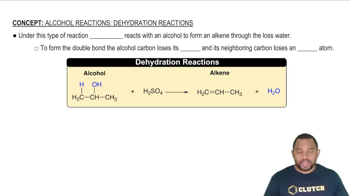Here are the essential concepts you must grasp in order to answer the question correctly.
Disproportionation Reaction
A disproportionation reaction is a specific type of redox reaction in which a single substance is both oxidized and reduced, resulting in two different products. In these reactions, one element undergoes an increase in oxidation state while another undergoes a decrease. This process is crucial for understanding how certain elements can react in multiple ways, often leading to the formation of different compounds.
Recommended video:
Alcohol Reactions: Dehydration Reactions
Oxidation States
Oxidation states (or oxidation numbers) are a way to keep track of electrons in chemical reactions, particularly in redox processes. They indicate the degree of oxidation of an atom in a compound, helping to identify which atoms are oxidized and which are reduced. Understanding oxidation states is essential for determining whether a reaction is a disproportionation reaction or not.
Recommended video:
Balancing Chemical Reactions
Balancing chemical reactions involves ensuring that the number of atoms of each element is the same on both sides of the equation. This is important for obeying the law of conservation of mass. In the context of the given reaction, balancing helps to analyze the changes in oxidation states and determine the nature of the reaction, including whether it qualifies as disproportionation.
Recommended video:
Balancing Chemical Equations

 Verified step by step guidance
Verified step by step guidance

